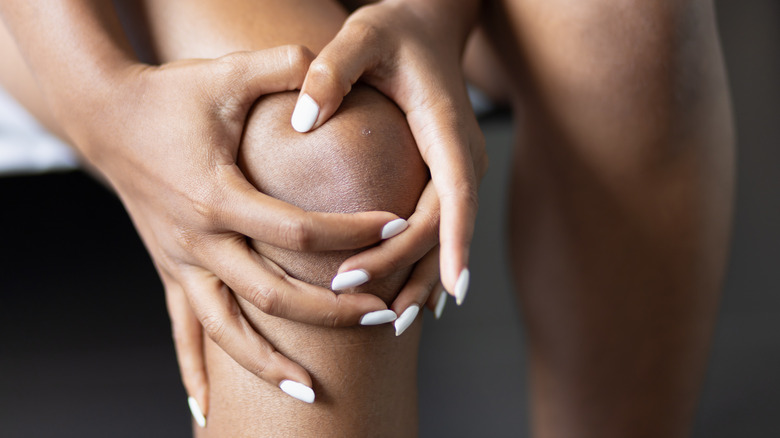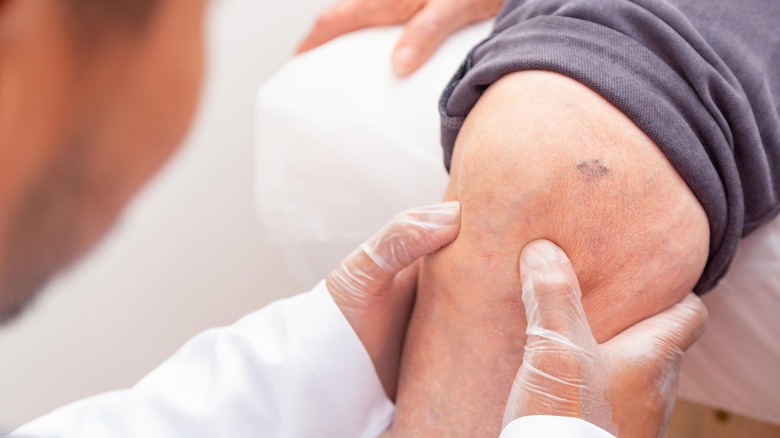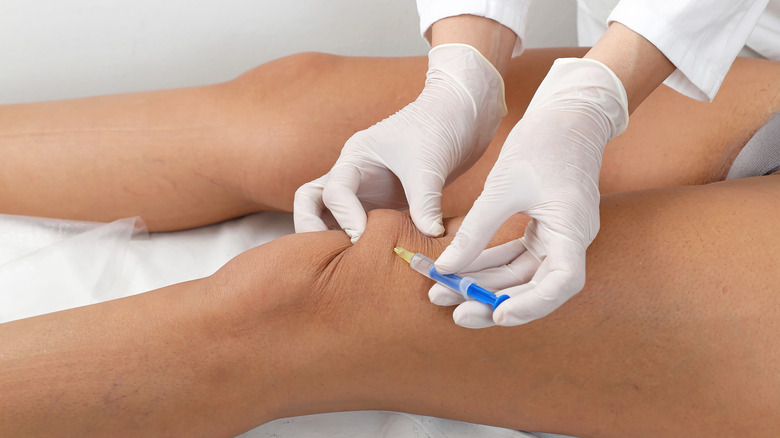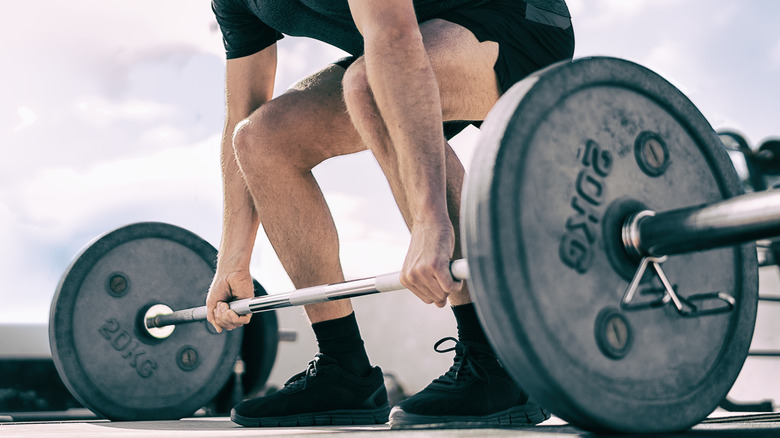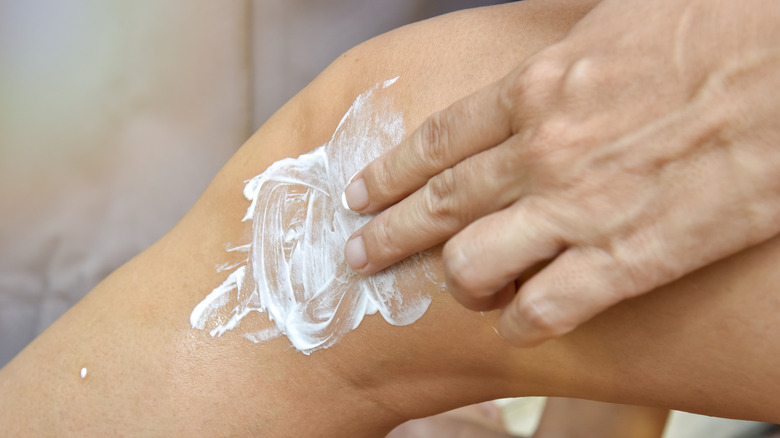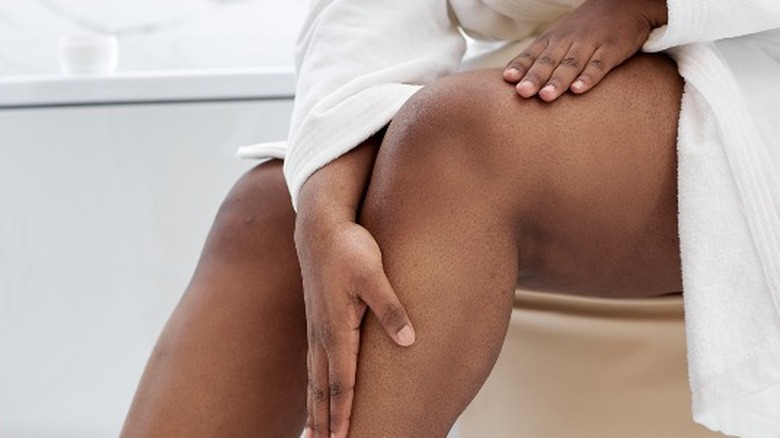Why Does Crepey Skin Happen On Your Knees & How Can You Fix It?
It's no secret that our skin and bodies begin to change as we get older. Quite literally, gravity does what it does best and, over the years, pulls our skin downward, appearing as what is cosmetically known as wrinkles. And, since skin is our largest organ and covers the body from head to toe, the wrinkles and fine lines you may fret over seeing on your face when you look directly in the mirror can appear on all areas of skin. Simply said, any areas of skin can succumb to gravity, resulting in folds, lines, and crevices that culminate in the wrinkles we accumulate with age.
One part of your body you likely don't observe very often in the mirror is your knees, which are also prone to developing crepey appearances of sagging skin — otherwise known as kninkles. Aside from the humorous terminology, crepey, folded skin above the knees, sometimes surrounding the knee caps, can be treated, restoring your kninkles to their youthful appearance from different in-office procedures and DIY hacks for smoothing, hydrating, and rejuvenating the skin.
While a good knee-high boot or sleek pair of tailored pants is always a top-notch fashion choice, being able to confidently show off your knees is important, too. Though you may not realize the appearance of your knees until the weather is warm enough to wear shorts, these non-invasive, in-office and at-home treatments are available all-year-round.
How knee skin becomes crepey and turns into kninkles
Add up the number of times you've bent down, moved your legs, walked up and down stairs, or simply changed positions while sitting at your desk or lounging on the couch. The answer to that equation is likely impossible to nail down with a precise number, but it's safe to say you've moved your legs around a significant number of times throughout your life. Each time your leg bends, even to the slightest degree, the skin around your knees moves with it. In essence, the crepey, sagging skin and wrinkles, a.k.a. kninkles, around your knees is a badge of honor for the life you've lived and how your legs — and your knees — have carried you through, quite literally.
Compounded with the weight-bearing functions of your lower joints, such as your knees and ankles, for balancing your entire body weight as you move around, your knees take quite the hammering. So, it isn't surprising that signs of age alongside quite a bit of wear and tear eventually begin to show up as creased, drooping, or sagging skin and crepey folds of kninkles. And don't forget gravity!
While you may be exceptionally proud of your knees for all the activity and range of motion they've given you, the appearance of crepey knee skin isn't always endearing. That's why efforts to maintain, rejuvenate, and protect knee and skin health are important.
Fillers are not just for your face
Fillers have become popular in-office medical- or spa-performed treatments for reducing the visibility of fine lines and wrinkles and, per their namesake, for filling in acne scars on areas around the face. Likely the most well-known injectable treatment is Botox, which temporarily firms skin and can contribute to the longevity of elasticity-providing collagen in the treatment areas. Another form of injectable solution available under the umbrella of dermal fillers involves solutions that can produce similar effects to that of Botox. These fillers can be applied to crepey knees to achieve the same results of plumping skin and tissue, prompting collagen production to encourage the skin's natural filler effect and reduce the appearance of fine lines and wrinkles — even kninkles.
Sculptra and Radiesse are the most effective dermal fillers for minimizing visible crepey knee skin and other knee-based concerns. Both dermal filler options are effective at instantly providing plumper-looking, age-defying skin around the knees, while giving your skin's natural connective tissue around the joints of your knees a growth boost that can continue even after the temporary effects of the fillers have faded. Non-invasive skin-tightening radiofrequency and ultrasound waves to tighten skin are additional in-office procedures that go a step beyond dermal fillers. They are available for knee-based treatments under the names Exilis Ultra and Thermage.
Lifestyle habits can impact your knees
Living a healthy lifestyle that emphasizes diet and exercise is one key way to keep crepey skin at bay. The key is to start prioritizing these actions today rather than waiting years down the road. You can easily incorporate multiple lifestyle habits into your daily routine to ward off crepey skin on your body, though it's important to note that these practices work best if you stay consistent as you age. Working out and eating a nutritious diet when you're young is great, but if you stop, you'll be back to square one when it comes to maintaining the firm, smooth skin around your knees and joints.
Weight training is one of the best forms of exercise for maintaining joint health, flexibility, and strength, largely due to the plump muscle mass retained beneath your knee skin, which keeps the skin's elasticity stretched out. In addition to pumping iron through routine weight lifting, make certain your diet is filled with the right nutrients and essential vitamins you need for longevity of your joints and skin health, including iron and vitamins A, D, E, and C. Taking a daily multi-vitamin is a simple act for promoting healthy skin on your knees.
At-home remedies are easily accessible
Applying moisturizing lotion from head to toe is one of the most effective skincare practices you can secure in your daily routine. Making certain your skin receives its necessary hydration — especially as sunlight's ultraviolet (UV) rays and common pollutants and free radicals can cause more damage to skin today than in past eras — should be a skincare priority. If you use nothing else on your knees, use an effective lotion. Finding a skin-firming lotion is even better, with over-the-counter (OTC) options available for under $10 at most nationwide retailers.
Beyond basic moisturizers and lotions, recommended options containing lactic acid for cell renewal and moisturizing elements such as shea butter are your sidekicks for success. Again, it can be easy to overlook the knees, even when applying lotion to dry skin on your calves and shins, but to prevent crepey skin from creeping up, your lotion game needs to be in tip-top shape!
Hydrocortisone cream, an ointment available over-the-counter and by prescription for stronger strengths, is effective for fighting the daily friction caused by knees rubbing against external pressures, from pressing against plastic components while driving and rubbing against your desk at work to clothing-induced friction. Additionally, you can ward off the onset of crepey skin and kninkles by applying sunscreen whenever your knees are exposed.
Your skincare products can work double duty
You may not have to make a trip to the store to begin restoring the skin on your knees and saying goodbye to crepey folds forever. The products you use to firm the skin on your face, increase collagen production, and promote cellular turnover through exfoliation and growth of new cells work perfectly well for the skin above your shoulders, and, as Joshua Zeichner, director of cosmetic and clinical research in dermatology at Mount Sinai Hospital, told Prevention, "...There's no reason you can't apply your face products to your elbows and knees, too."
In particular, look for products on your bathroom counter or in your cabinet that contain hyaluronic acid — a common ingredient used in dermal fillers — or retinol, which has anti-aging skincare benefits for more than just your face. Glycolic acid is also a great exfoliator for shedding dead skin cells, thus stimulating cellular growth. If you have skincare products you love, try them on your knees. While the results will likely take longer to transpire because the skin is thicker, over time, you'll experience rejuvenated knees.
Since facial skincare products are not restricted solely to your face, embrace using them on other areas of your body with sagging or visibly aging skin. In fact, the restoration and treatment methods used to stimulate collagen production and cell turnover in knees can also be used for restoring the firmness of skin on and around your elbows, making these methods triple wins!
